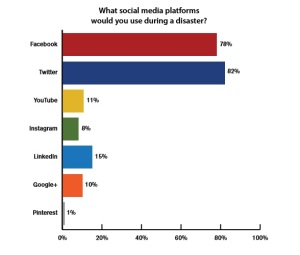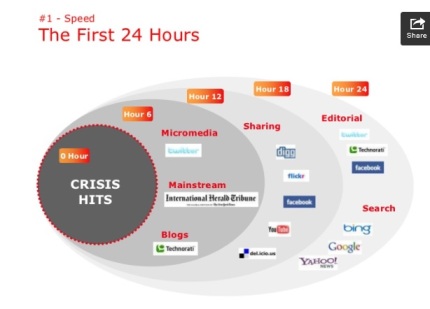The recent tragic disappearance of Malaysian Airlines Flight 370 reminded us how quickly a crisis can escalate and rampage out of control. Which of us thought, “What do I do if this happens to my company?” When our businesses or organizations are involved in a crisis of this nature, there is an overwhelming volume of information to process and distribute, while multiple international media, global agencies, and the public, clamor for attention. In these instances, social media can be a useful tool for monitoring, informing and engaging stakeholders and the public and helping business continuity.
HOW BUSINESSES CURRENTLY VIEW SOCIAL MEDIA FOR CRISIS COMMUNICATION
Continuity Insights Crisis Communications 2014: Social Media & Notification Systems surveyed 270 organizations over 3 years and determined:
• Businesses are using social media more to communicate with the public (Facebook and Twitter) but less internally to communicate with their employees. (Tools like Yammer had decreased in usage.)
• 52% of the businesses felt the benefits of using social media in a crisis outweighed the risks
• 62% planned to use social media to gather information during a crisis. 43% had a plan to verify the information it had. Most used Google Alerts for monitoring.
• 70% use notifications system, mainly email, phone, and SMS. Almost 50% use dedicated mobile apps. New notification systems like geospatial mapping increased in use by 4%
• 66% had an assigned person to handle inbound-outbound communications during a crisis
• 58% felt mobile technologies (smart phone, tablet) were vital for executing crisis communications plans
• Only 44% had a social media plan to use in a crisis.
WHAT BUSINESSES FEAR ABOUT SOCIAL MEDIA FOR CRISIS COMMUNICATIONS
The most prevalent fear regarding social media usage was the reputational risk by releasing incorrect or private information. The Continuity Insights survey listed the following concerns:
1. Deliberate misinformation – unfair and unfounded detractions are posted about the company
2. Security breaches – how to keep information and privacy protected?
3. Lack of control – message extends beyond the intended audience, and difficult to control rumor.
4. Congruity – tied to using the same channels once you start, frequent need to communicate.
5. Employee issues – resourcing, appropriateness of messaging, lack of understanding of social media, malicious gossip.
WHY USE SOCIAL MEDIA IN CRISIS COMMUNICATION
The New Normal
Despite the issues listed above, these are some excellent reasons to use social media in a crisis:
1. Effective Reach – Social media can be an effective way to get your message out and engage your public. The chart below below shows the increasing importance of social networking in the U.S.
Social Networking is the No.1 Online Activity in the U.S. Source: Statista, The Statistics Portal, Mashable
2. Citizen journalism – The public will report on a crisis via social media and may even do so before you or the traditional broadcast media know about it.
3. Conversation – People are talking about the crisis to each other on social media. After Japan’s 2011 earthquake 70% of people used Twitter, 37% used Facebook and 16% used YouTube for information and sharing. We need to be a part of the conversation if only to explode myths and offer reassurances.
4. Response required – The public expects a response to their comments and questions.
5. Real time – It was called “Ground Truthing” during the Gulf War which meant finding out what happened and reporting it immediately.
6. Openness – People expect a flood of information. And updates as they happen. During the BP oil spill, people were asking the disaster response team for better angles on the underwater “leak cams.”
7. Engagement – The University of Western Sydney (Australia) after a flooding disaster said social media helped people feel “connectedness and usefulness, felt supported by others and encouraged.” Source: David Mistick: Using Social Media in Crisis Communication
FIRST ANSWER THESE QUESTIONS
Picture source: Cinnamon Edge Publishing UK
Consider the following before you formulate your social media plan:
1. Is social media the best way to reach your public? Different demographics use social media differently. You need to know your audience and how they use social media.
2. Which channels are most effective for your message?
3. Do you have the connectivity you need? After the Boston Marathon bombing, commercial cellular wireless carriers overloaded and crashed. Video sharing was a big problem. Until the national public safety broadband which is still in planning stages is executed, have back up communication plans.
4. Do you have the personnel resources you need? And are they sufficiently trained in the medium and to deal with questions?
5. Can you explain controversial business practices?
6. Are your company’s outreach, communication and goodwill efforts sincere?
TIPS TO USE SOCIAL MEDIA EFFECTIVELY IN A CRISIS
This Ogilvy presentation offers detailed tactics for using social media in a crisis. Here are some other ideas based on the stage of the crisis:
PRE-CRISIS
Social media is an effective way to prevent a crisis, by monitoring conversations for issues arising, and addressing them before they reach crisis proportions. It also allows businesses to establish a relationship and understand priorities and motivations of their public.
1. Have a voice – Be present on social media channels before a crisis occurs. Now is the wrong time to set up social media accounts or try to establish a voice. You should already be credible and have an audience. You should also have a “fan” community who can get messages out when needed.
2. Make, Test, Update a Social Media Crisis Communication plan – winging it is the surefire way to fail in a crisis. A solid tested and frequently updated plan must be in place. Here are some references which may help create a useful plan from:
10 Must Have Elements for a Social Media Crisis Plan – Chris Syme
3. More is better – PR and Communications pros tend to stick with trained spokespersons. But the reality of our globally connected world is that employees are already speaking to their friends and families. Eric Schwartzman advised utilizing as many employees as possible to get the message out on social media. Why not train people to “stay in their lane” and offer employees Q&A’s and the chance to be goodwill ambassadors for your business?
4. VOST – Virtual Operations Support Team must be in place to process and distribute relevant information
DURING THE CRISIS
Unfortunately unprecedented and unforeseen circumstances may occur at any time. Here is how social media can help you manage through the crisis:(Source: David Amerland, 4 ways to exploit the opportunity, Forbes BrandVoice)
- Acknowledge the crisis
- Explain what you’re doing
- Provide a solution (where possible)
- Show empathy
1. Stop all scheduled social media communications – use the resources and media for only crisis communications
2. Take control – From the onset. Malaysian Airlines missed the opportunity to use the trending hashtags #MalaysianAirlines and #MA370. Their tweets went out on #MASAlert. Also ensure you own your brand name and detractions like “fail” on social media channels whether you actively utilize the medium or not.
3. Panel vetting – Have all messages screened before release by legal, leadership, stakeholder and communications representatives.
4. Rumor control – Scare mongering is unfortunately easy on social media. “Sharks in the subways” was the highest trending message on Twitter during Hurricane Sandy. FEMA set up a rumor control center on their official website and shared links to social media.
5. Explain what you’re doing – or the public will assume you’re indifferent http://www.forbes.com/sites/netapp/2013/12/31/social-media-crisis/
6. Monitoring – Continuity Insights offered options of TweetDeck and HootSuite as it felt Google Alerts was not useful for real time monitoring and situational awareness. Monitoring may need to be hourly.
7. Co-operation – Some companies have written policies in place to ensure co-ordination between the Business Continuity team and Corporate Communications Department who are most likely to manage social media.
POST CRISIS
Social media can help follow up public opinions and issues post crisis and also segue back into business as usual:
1. Reclaim – Remind the public that the crisis is not the identity of the company is a good place to start.
2. Measure – find out how you did. The criteria varies but response time, reach and effectiveness are standard measures which are useful.
These articles touched on some interesting points in crisis communications measurement including whose opinion matters and a scorecard idea.
How to easily measure crisis communications performance – Jonathan Bernstein
Post Crisis Measurement – Orchestra Communications
WHAT TO AVOID AT ALL COSTS
Picture source: Docsee
1. Silence – This makes everything worse. Nature abhors a vacuum and a deafening silence is likely to be filled with wild speculation and negative opinions about the organization involved.
2. Nuclear reaction – if you delete everything uncomplimentary or controversial from your social media channels you may as well say goodbye to your credibility and the trust of your public.
3. Defensiveness – do not blame others and do not attack people you may perceive as detractors. The public forms an idea of your company with each interaction.
4. Insensitivity – social media is not a replacement for a physical human presence or face to face conversations. Malaysian Airlines informed families that all the lives on Flight 370 was lost via text message which resulted in severe criticism from the public.
“There is value in taking advantage of free social media platforms, and the knowledge of staff in how to use them, but it is a common challenge that organizations are not staffed and organized to fully capitalize on the potential of social media for situational awareness and crisis communications, especially as it applies to mobile.” Brian Gray, Chief, Business Continuity Management Unit, United Nations







Nice post